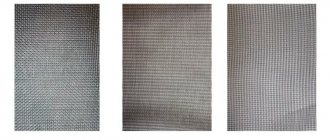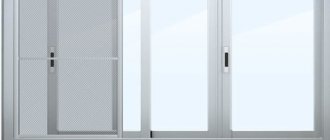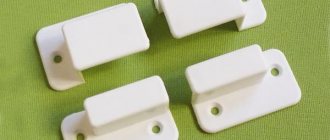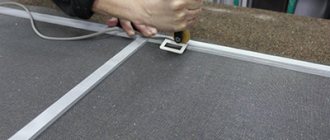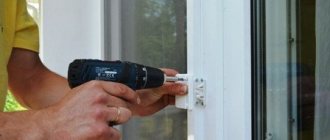Admit it, do you also have a lot of questions about mosquito nets?
If you don't understand why the text begins with this question, then in a previous article we gave a brief overview of the types of mosquito nets and their evolution over time.
Everything seems to be simple. When we talk about a mosquito net, we mean an aluminum frame with a stretched mesh fabric. But, there are nuances. While studying the websites of sellers, you probably noticed what a variety of designs they offer. For example, you want to put a net on a window in your apartment. It is important to take into account the design of the window, whether there is space for installing fasteners, whether there are restrictions in the form of bars, what the mesh should protect from, where the window goes, etc. These details determine which design will solve your problems.
In this article we will look at the main types of mosquito nets.
Types of mosquito nets for plastic windows
Designs are distinguished by:
- installation location - windows, doors, for large openings (arched and U-shaped);
- type of frame - frame and frameless. The first type is a rectangular or other shaped rigid frame on which a mesh is stretched. The second type - a rigid frame is available only on one side of the usually rectangular panel. The opposite side is fixed on a base - a roller or a stand; the side parts are equipped with a flexible, durable edging. There are also net curtains and nets with Velcro, we will talk about them separately;
- on the possibility of opening/removal and the opening mechanism. Fixed screens are rarely installed; their frame is mounted directly into the window frame. Usually these are homemade products for wooden structures. Removable ones are usually framed, placed in special mounts and easily removed from them. Opening ones are divided into swing, sliding, roller and pleated. Net curtains do not have an opening mechanism (usually), they are simply pulled apart by hand;
- by the type of mesh itself - a larger or smaller cell, the strength of the fibers and their material, the ability to transmit light, etc.
Windows with hinged or sliding sash/s are fitted with either removable or movable screens. In doorways and arched ones - only movable ones. An exception may be very rarely used doorways or arched (U-shaped) doorways not used for passage.
Let's take a closer look at the different types of meshes.
Frame removable nets
This is the most popular and budget type of product. The frame is made of durable, hard plastic or lightweight metal (usually aluminum). If a particularly strong structure is required, a steel profile and special reinforced fasteners are used. In this case, the grid becomes an additional “line of protection.”
The production of frame structures is established in almost all companies that produce plastic and aluminum windows, doors, and other types of glazing. They are made to fit the size of standard windows/doors or according to individual measurements.
Fastening is used using clamps or “pockets” into which the frame is inserted.
Metal mesh on a metal frame is attached with a special fastener - a plunger - to the frame. This allows them not to fly out when impacted by a blow or push (for example, a playful child or pet ran into the net). A plunger is a pin on a spring.
Interestingly, such products are produced under the name “anti-cat mosquito nets” or “anti-cat”.
Z-shaped fasteners (“pockets”) require the mosquito frame to be larger than the opening and do not provide a tight fit. But they are cheap and easy to replace.
If desired, removable frame structures can even be installed on old wooden frames. In this case, Z-shaped mosquito mounts are screwed to the frames from the outside, usually four (for small windows or vents), or six or more for large openings.
Different types of mosquito net fastenings are used depending on the circumstances and financial capabilities of the customer. As already mentioned, plunger fastening is more reliable and durable, while bracket fastening (Z-shaped fastening) is cheaper and simpler.
"Antibird"
Standard canvases are not resistant to bird pecking. Although the polymer mesh itself does not arouse their interest, bugs and midges attract close attention. Birds peck at prey, which leads to holes appearing in the thin weave. After this, the mesh no longer protects against insects and must be replaced.
In order not to repair the canvas several times per season, a special “Antiptitsa” mesh is produced with reinforcement with aluminum threads. The thinnest metal protects well from pecking, and the mesh remains intact.
“Antiptitsa” can be used for frame, sliding and roll nets without restrictions. It is resistant to corrosion, transmits light well, and lasts a long time.
Mosquito nets “Anti-dust” and “Anti-pollen”
The fabric of such mosquitoes differs from the standard one in that the mesh size is smaller - about 0.6-0.8 mm. Dust and pollen do not penetrate into the room, which allows people with allergies to feel much better with open windows.
In order not to reduce breathability, the mesh is made from the finest fibers. Therefore, “Anti-dust” and “Anti-pollen”, trapping the smallest particles, transmit light no less than usual. Such accessories cost 1.5-2 times more, which is fully justified by the clean air in the room and fewer allergic reactions in people prone to this.
Swinging and sliding mosquito nets
When figuring out which mosquito nets are better, many will remember the inconvenience of removing the removable structure and will prefer the opening option - hinged or sliding.
In fact, these are the same frame products, however, they are not attached to the frame using temporary clamps, but are mounted on it thanks to hinges or sliding mechanisms.
Most often they are used not on windows, but on doors or in unglazed openings - that is, where it is necessary to pass.
The swing mesh is attached so that it opens in the direction opposite to the door opening (the door is inward, the mesh is outward). The size of the frame is selected so that it completely covers the opening with a margin.
In sliding and swing structures that do not completely cover the opening (due to the absence of a threshold, for example), brush or polymer seals are used around the perimeter.
They do not allow insects to penetrate into the resulting gap.
Sliding models can have only top guides or a set of guides at the bottom and top.
For window structures, the second option is usually used, for door structures - both.
To ensure the mobility of the sash, an additional profile is attached to the frame.
Most often, hinged versions of mosquito nets are used with hinged doors and windows, sliding ones - with sliding ones, but variations are also possible.
Repair of mosquito parts
If the mosquito net breaks, there are two options: contact a window manufacturing or repair company, or try to repair it yourself.
In order to replace the canvas, you will need:
- new canvas;
- fastening cord;
- pens;
- screwdriver;
- sharp knife (can be a stationery knife).
Repair sequence:
Place the damaged mesh on a horizontal surface.- Using a knife, pry the end of the fastening cord and remove it from the groove of the frame, removing the old canvas.
- Place the new mesh fabric on the frame with an allowance of 1.5-2 cm.
- Place the fastening cord on top and use a screwdriver to press it into the groove, starting from any corner, moving along the perimeter of the frame. In this case, you need to ensure that the canvas is stretched evenly over the frame, without distortions.
- Using self-tapping screws, attach the new handles to the frame.
- Trim the excess edges of the canvas with a knife.
Mosquito mosquito repairs are also discussed here.
Roller type mosquito nets
This design (otherwise called a rolled mesh) is a horizontally or vertically located roller protected by a special overlay profile. A mesh panel is wound on the roller, the opposite edge of the fabric is supplemented with a bar with a holder for moving, the sides are reinforced. Runners are attached to the bar and slide along guides placed perpendicular to the axis of the roller.
By moving the bar up or down, you can completely or partially cover the opening with a mesh or roll it up, almost completely hiding it from view.
The holder and guides are attached to the outside of the window or door opening.
The size of the roller shutter mesh is selected so as to cover the opening with a small margin.
It is interesting that a model with a horizontal roller arrangement is usually single, but with a vertical position of the axis of rotation it can be double. When touched, the two halves of the mesh are connected by a latch.
It is worth choosing any of the roller shutter varieties when there is no room to move or open the mesh shutter, and you need to remove it from the opening regularly.
Automated ZIP system
A specific mosquito net that protects not only from insects, but also performs the function of sun protection, protection from precipitation and tinting. This effect is achieved through the use of a special cloth SKRIN (Screen) made of high-strength composite material.
The system is installed on large openings up to 10 meters wide and 4 meters high. For this reason, the structure is made of reinforced aluminum profiles and is protected from blowing out the canvas during strong gusts of wind. The system operates on the principle of a rolled mesh, but instead of a spring, a motor is installed in the box on which the fabric is wound. Control is carried out from a remote control or switch button.
In the following reviews we will look at each system in detail. Let's study all the pros, cons and design features.
Pleated mesh
This is another original modern design designed to save space.
It is placed both on doors and windows, on open openings. For the structure to work, two guides are needed - at the top or bottom (or on the sides, for vertical movement).
A special feature of the product is the pleated panel - that is, “folded in folds”. The guides are selected to match the width of the fold, and the panel is “stitched” with a strong cord.
This variety is described in more detail in the video. They are especially good when you need to cover a large opening.
When to install an impost
Standard mosquito nets are made from a lightweight profile with a width of 25 mm. At a height of more than 1 m, the vertical elements of the frame may bend inward, creating gaps between them and the window.
To avoid deformations, an impost is built into the structure - a flat crossbar that imparts rigidity. It breaks the panorama into 2 parts, which not everyone likes. But there is a way out - to make a mesh from a more powerful profile with a width of 32 mm, although this will cost a little more.
Homemade products and substitutes
When understanding what kinds of mosquito nets there are for doors and windows, many people wonder – is it worth spending money on ready-made structures? Isn't it better to do the same yourself?
In fact, it is not so difficult: with some skills, any home craftsman can assemble the frame and stretch the mesh fabric onto it. Usually there is a problem only with uniform tension of the mesh. In this case, you can use a “partially ready-made solution” - a Velcro panel. By sewing one piece of Velcro around the perimeter of the mesh and gluing/nailing/screwing the mating part onto a frame or a specially made frame, you can get a good substitute for a factory mosquito net.
What’s interesting is that such a cloth can be easily washed – just unfasten the mesh from the Velcro and off you go, either in a basin or in a washing machine. However, machine washing is still not recommended.
Another budget option is a mesh curtain with magnets.
Usually it is attached to the door. This mesh has a U-shaped fastening contour (with Velcro, special tape, and so on). The curtain halves can be easily pulled apart. When released, they are attracted to each other by magnets inserted into the edging of the panels. The same thing happens below - here magnets are inserted into the bottom of the mesh and into the threshold (a frame or tape placed on it). Cheap models do not have magnets at the bottom.
How to do it yourself?
Before you start assembling a mosquito net with your own hands, the first thing you need to do is take accurate measurements of the future element. Then follow the instructions:
- The plastic frame profile is cut taking into account the measurements taken.
- The sides of the frame are fastened with plastic corners.
- The mesh is placed on the frame and secured with a cord, which is pressed into special grooves on the frame profile.
- If desired, place a crossbar in the center - this will add rigidity to the structure.
- Loop holders are attached to the finished mosquito net on both sides so that it can be conveniently installed outside the window.
Another way to make a mosquito net with your own hands is described in the video:
Read more about how to make a mosquito yourself in the article.
Types of mesh
It was already mentioned above that a metal mesh is used for anti-cat models. For conventional products, PVC-based mesh fabric is used. Depending on the cell size, fiber thickness, its material (PVC, metal, fiberglass) and color, different types of panels are distinguished:
- standard;
- small;
- large;
- with special properties - more durable, less blocking of light, and so on.
Which one to choose for PVC structures?
To choose the right mosquito net, you need to decide on the following questions:
- choose the design of the mosquito net;
- make an accurate measurement of the window opening (width and height) - this must be done with the sashes open;
- if there are animals in the house, you may need the “anti-cat” option;
- the need to close/open the mesh and remove the element for winter storage;
- the presence of decorative elements or coloring;
- additional qualities (“anti-pollen”, light reflection, etc.).
Regardless of what material the mesh fiber is made of, you need to inspect the quality of the threads, check them for strength, as well as for the presence of an unpleasant odor. Decide on the size of the cells. They can be 0.6 - 1.2 mm.
It should be remembered that fabrics with very small cells will be less breathable. This option is suitable if the room needs to be protected from small midges or if there is an allergy sufferer in the house, since small cells can partially retain pollen. Small insects will penetrate through cells that are too large.
Having decided on the parameters of the mosquito net, you can place an order from the manufacturer.
